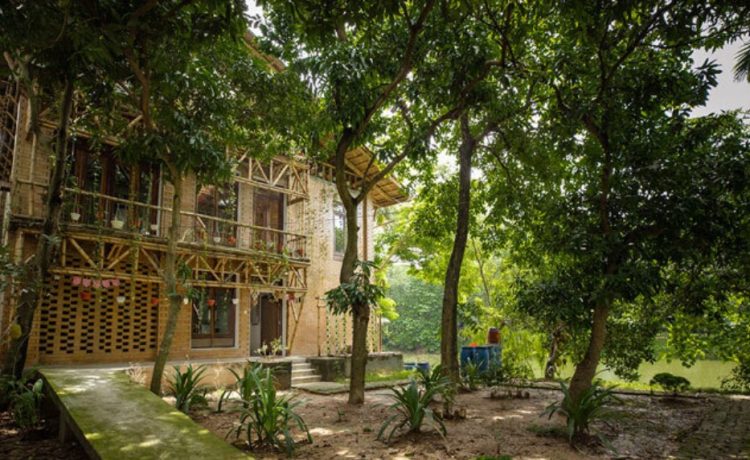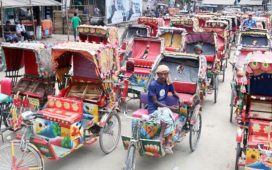When temperature had climbed to 35°C, with humidity hovering at 70%. Outside, the air shimmered with heat, and the city buzzed under a thick haze. Yet inside a modest structure on the outskirts of Dhaka, the atmosphere was calm. The interior held steady at 26°C, despite the sweltering conditions beyond its walls.
This is the amphibious house, a pioneering structure designed not only to withstand Bangladesh’s escalating climate crises but to actively combat them, describes BRAC’s communication specialist Nafisa Islam.
Built from earth blocks, bamboo, and sustainable design principles, this house floats during floods, stays cool without air conditioning, generates its own power, grows food, and costs less than conventional housing. In a country ranked the seventh most climate-vulnerable nation in the world, it represents a radical reimagining of shelter, she narrates in BRAC’s blog ‘The Good Feed’.
Bangladesh: On the frontline of climate chaos
Bangladesh is the third hottest country in South Asia and frequently records the worst air quality on the planet. In recent years, heatwaves have reached 42°C (108°F), the highest in 76 years, melting roads and forcing schools to close. With a population of over 170 million packed into a low-lying delta, the country faces a convergence of climate threats: cyclones, floods, rising seas, and now, deadly heat.
A major contributor to the crisis is the construction industry. Around 7,000 traditional brick kilns operate across the country, producing approximately 23 billion bricks annually. These kilns are responsible for 17% of Bangladesh’s total CO₂ emissions, around 15 million tonnes per year, and release vast quantities of particulate matter, carbon monoxide, and other toxic pollutants.
Air pollution now cuts the average Bangladeshi’s life expectancy by 6.7 years, and is linked to one in five premature infant deaths. The need for change is urgent.
The amphibious house: A home that adapts
Developed through a collaboration between the University of Dundee, Resilience Solutions Bangladesh, and BRAC University’s Centre for Climate Change and Environmental Research (C3ER), the amphibious house is a prototype of resilience. It was awarded the UN’s Risk Award in 2019 for its innovation, durability, and sustainability, and continues to evolve with support from the Munich Re Foundation and the Scottish Government.
Floating through floods
When floodwaters rise, the house floats. A cavity beneath the foundation fills with water, activating a buoyant base that lifts the entire structure. Four vertical guide posts at the corners prevent lateral drift. Once the waters recede, the house gently settles back onto its base — intact and ready for use.
This feature is critical in a country where millions are trapped in their homes during floods. In August of the previous year, some families remained stranded for nearly four days before rescue.
Cool by design
The walls are made from low-carbon earth blocks made of clay, sand, and lime compressed and chemically hardened without firing. Unlike conventional bricks, these blocks absorb CO₂ during curing, making them carbon-negative.
They also provide superior thermal insulation, keeping interiors cool year-round. Inspired by the human body’s ability to regulate temperature, the design allows for natural ventilation, eliminating the need for energy-intensive cooling.
Self-sufficient living
During disasters, when infrastructure fails, the amphibious house functions as a self-contained unit:
Water: 17,000 litres collected from rainwater, filtered, and reused.
Food: Indoor permaculture, outdoor aquaponics, and small-scale poultry farming.
Energy: A 5 kW solar panel system powers the home, with options for off-grid battery storage, wind turbines, and solar concentrators.
Rooted in tradition, reinvented for tomorrow
Bangladesh has a rich architectural heritage of passive cooling. The 17th-century Tahkhana Complex in Chapainawabganj, for example, used courtyards, water bodies, and strategic airflow to maintain comfort, all without electricity.
But as urbanisation accelerated, these techniques were abandoned in favour of concrete and glass. Brick kilns, once small and local, became industrial-scale polluters.
The amphibious house revives traditional wisdom with modern science. By replacing fired bricks with low-carbon alternatives, it directly tackles a major source of emissions. The government has already begun phasing out non-compliant kilns, aiming to ban all conventional brick production by 2025.
Low-carbon bricks emit 90% less CO₂ than traditional ones. If adopted at scale, they could drastically reduce pollution and save thousands of lives.
Beauty in sustainability
The house is not only functional, it is beautiful.
Sunlight streams through bamboo lattices, casting warm, honeyed patterns on clay-painted walls. A grand, curving bamboo staircase serves as a centrepiece, while a rooftop opening creates a natural spotlight on the floor below.
The bamboo is treated with boric acid and borax – non-toxic salts that deter termites and fungi by altering the plant’s natural sugars. The exterior is sealed with resin for weather resistance, and all paints are clay-based, free from volatile organic compounds.
Inside, the air feels fresh, quiet, and alive.
Scaling the solution and the challenges
Despite its promise, the amphibious house remains a prototype in the early stages of scaling.
The earth blocks require factory production to meet demand – a capacity that does not yet exist in Bangladesh. While countries like the UK, Denmark, and the US are investing in large-scale low-carbon brick manufacturing, Bangladesh lacks the policy incentives, financing mechanisms, and market awareness to drive widespread adoption.
“There’s strong interest from communities and researchers,” says Dr Saleh Ahmed of C3ER, “but without government procurement policies and financial support, it’s difficult to move from pilot to mass production.”
Public perception is another barrier. For many, a house made of earth and bamboo still feels temporary – not a permanent, dignified home.
From Bangladesh to the world
The design is inherently adaptable.
Its modular, box-style structure suits urban and rural settings alike. The jute fibres in the bricks can be replaced with coconut coir, straw, or hemp, depending on local materials. This makes the model relevant not just for Bangladesh, but for flood-prone regions across South Asia, Africa, and Southeast Asia.
As climate disasters grow more frequent and severe, the need for resilient, low-carbon housing is global.
A glimpse of the future
When the correspondent stepped back outside, the heat and smog returned – a stark contrast to the tranquillity within.
But the experience left a lasting impression: that housing can be more than shelter. It can be a tool of climate adaptation, a generator of life, and a statement of resilience.
In a world increasingly defined by environmental breakdown, the amphibious house offers a vision of the future, one where homes don’t harm the planet, but help heal it.
And in a country on the frontlines of climate change, that vision may be the most important innovation of all.





